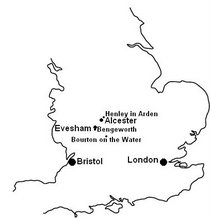In a 1976 essay entitled George Whitefield's curate: Gloucestershire Dissent the late Geoffrey Nuttall notes that John Olding (1722-1785) a Dartmouth born English Congregationalist minister who studied under Doddridge at his Academy in Northampton, 1740-1743 and moved from Gloucester to Deptford in 1754, issued a broadsheet in 1768 headed
A Modern Pattern for Gospel Ministers, taken verbatim from an Inscription upon the Grave Stone of the Late Truly-Reverend Mr. THOMAS COLE, whose Remains lie intered in the Meeting House without the South-Gate in the City of Glocester. He signed it with a number of other 'Ministers of the Gospel' including Beddome, Earlier in the essay Nuttall says that Thomas Cole (1679-1742) was a godly nonconformist who Whitefield admired.
The document describes Cole as 'very eloquent, informing, awakening. evangelical, and casuistical; labouring much to abase the Sinner, and exalt Christ and Free Grace'. Nuttall suggests this is evidence of Cole's continuing influence to the south, east and west, as well as in London and Gloucestershire. It is on the basis of 'personal and intimate Acquaintance' with Cole that 10 ministers put their names to the manifesto. Besides Beddome there are two from London, two from Somerset, four based in Gloucestershire and George Whitefield.
1. William King (1701-1769) Wiltshire born Independent minister who studied in Utrecht, returning to England in 1724. The following year he became minister in Chesham, being ordained 25 April, 1725. He removed to London in 1740, and on 14 February became pastor of the Independent church in Hare Court, Aldersgate Street, succeeding Samuel Bruce. He was created DD shortly after. On 14 January,. 1748 he was chosen Merchants' lecturer at Pinners' Hall. He died on 3 March 1769. He was buried in Bunhill Fields. An oil-portrait of King exists.
2. Samuel Philips had been in Bunhill Walk but then moved to Newbury in Berkshire.
3. Philip Jones of Upton-upon-Severn (c 1700-1771) a Baptist and a fellow trustee of the Seward fund with Beddome was briefly at Cheltenham before moving to Upton in 1731, where he also pastored (from 1727) the Seventh Day Baptist Church at Aston Natton. He often preached and was moderaotr in the Midland Association. He appears to be the nephew of Philip Jones assistant pastor Rhydwilim, Wales and the father of Edward Jones (d 1765) who pastored in Exeter.
4. Hugh Evans of Bristol (1712-1781) a Baptist minister and Academy tutor, he was a member of a family prominent in the history of the Baptist denomination in Radnorshire and north Brecknock - his very name, indeed, was given him in memory of a local Baptist ‘father’. His grandfather was Thomas Evans (1625-1688), his father was Caleb Evans (1676-1739). He took out a preaching-licence in 1705 and became pastor at Pentre (Llanafan-fawr, Brecknock). Hugh Evans was educated under David Price at Llwyn-llwyd Academy near Hay. He then went to live with an aunt at Bristol, where he received baptism and was in 1740 [7 Feb.] chosen coadjutor to Bernard Foskett, minister of Broadmead Baptist church and head of the Bristol Baptist Academy. On Foskett 's death (1758) Evans succeeded him in both functions. His own son was Caleb Evans (1737-1791). Hugh Evans regularly attended Welsh association meetings and preached thereat 17 times ‘always in English, but repeating portions of his sermon in Welsh.'
5. George Gibbs Congregationalist minister of Thornbury from about 1733.
6. Benjamin Beddome of Bourton Baptist
7. Samuel Ball (d 1779) of Stroud Congregationalist
8. William Adam, late of Painswick (1730-1754) but then of Gloucester
9. William Gardiner of Wilton/ Studied at Mile End Academy?
10. George Whitefield, a native of Gloucester (in the country for the last time and 'much enfeebled')
The document was published by Robert Raikes (1736-1811).












No comments:
Post a Comment